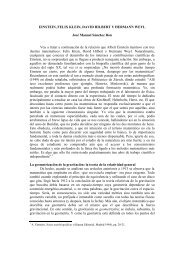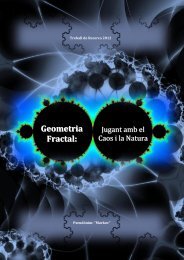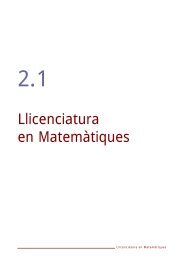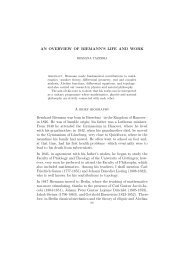FUNCIONES THETA DE RIEMANN 1. Introducción El objetivo de ...
FUNCIONES THETA DE RIEMANN 1. Introducción El objetivo de ...
FUNCIONES THETA DE RIEMANN 1. Introducción El objetivo de ...
You also want an ePaper? Increase the reach of your titles
YUMPU automatically turns print PDFs into web optimized ePapers that Google loves.
212 E. GÓMEZ AND J. M. MUÑOZ<br />
La función theta es la función analítica en C × H <strong>de</strong>finida por la siguiente<br />
serie absolutamente convergente:<br />
θ(z, τ) = <br />
exp(πin 2 τ + 2πinz) con z ∈ C, τ ∈ H<br />
n∈Z<br />
Esta función verifica las siguientes propieda<strong>de</strong>s:<br />
− θ(z + 1, τ) = θ(z, τ)<br />
− θ(z + τ, τ) = exp(−πiτ − 2πiz) · θ(z, τ)<br />
− θ(z + aτ + b, τ) = exp(−πia 2 τ − 2πiaz) · θ(z, τ)<br />
Otra <strong>de</strong> las relaciones fundamentales que satisface la función theta es<br />
la ecuación <strong>de</strong> calor:<br />
∂ 1<br />
θ(z, it) =<br />
∂t 4π<br />
∂2 θ(z, it)<br />
∂z2 Se verifica que la función theta está caracterizada por estas propieda<strong>de</strong>s,<br />
es <strong>de</strong>cir, periodicidad y ecuación <strong>de</strong>l calor.<br />
2.<strong>1.</strong> Funciones theta y grupo <strong>de</strong> Heisenberg. <strong>El</strong> grupo <strong>de</strong> Heisenberg<br />
<strong>de</strong> dimensión 3 se <strong>de</strong>fine como:<br />
G = C ∗ 1 × R × R , don<strong>de</strong> C ∗ 1 = {z ∈ C: |z| = 1}<br />
con la siguiente ley <strong>de</strong> grupo:<br />
(λ, a, b) · (λ ′ , a ′ , b ′ ) = (λλ ′ exp(2πiba ′ ), a + a ′ , b + b ′ )<br />
Se verifica que el centro <strong>de</strong>l grupo <strong>de</strong> Heisenberg es C ∗ 1 que coinci<strong>de</strong><br />
con el subgrupo conmutador.<br />
<strong>El</strong> teorema <strong>de</strong> Stone-von Neumannn afirma que existe una única representación<br />
unitaria e irreducible <strong>de</strong> G en la cual C ∗ 1 actúa por la<br />
i<strong>de</strong>ntidad. Esta representación se pue<strong>de</strong> realizar <strong>de</strong> la siguiente forma.<br />
Sea E el espacio <strong>de</strong> las funciones enteras (funciones holomorfas en todo<br />
el plano complejo) con la siguiente norma <strong>de</strong>finida a partir <strong>de</strong> un<br />
elemento τ ∈ H:<br />
||f|| 2 <br />
=<br />
exp(−2πy<br />
C<br />
2 / Im τ) · |f(x + iy)| 2 dxdy










